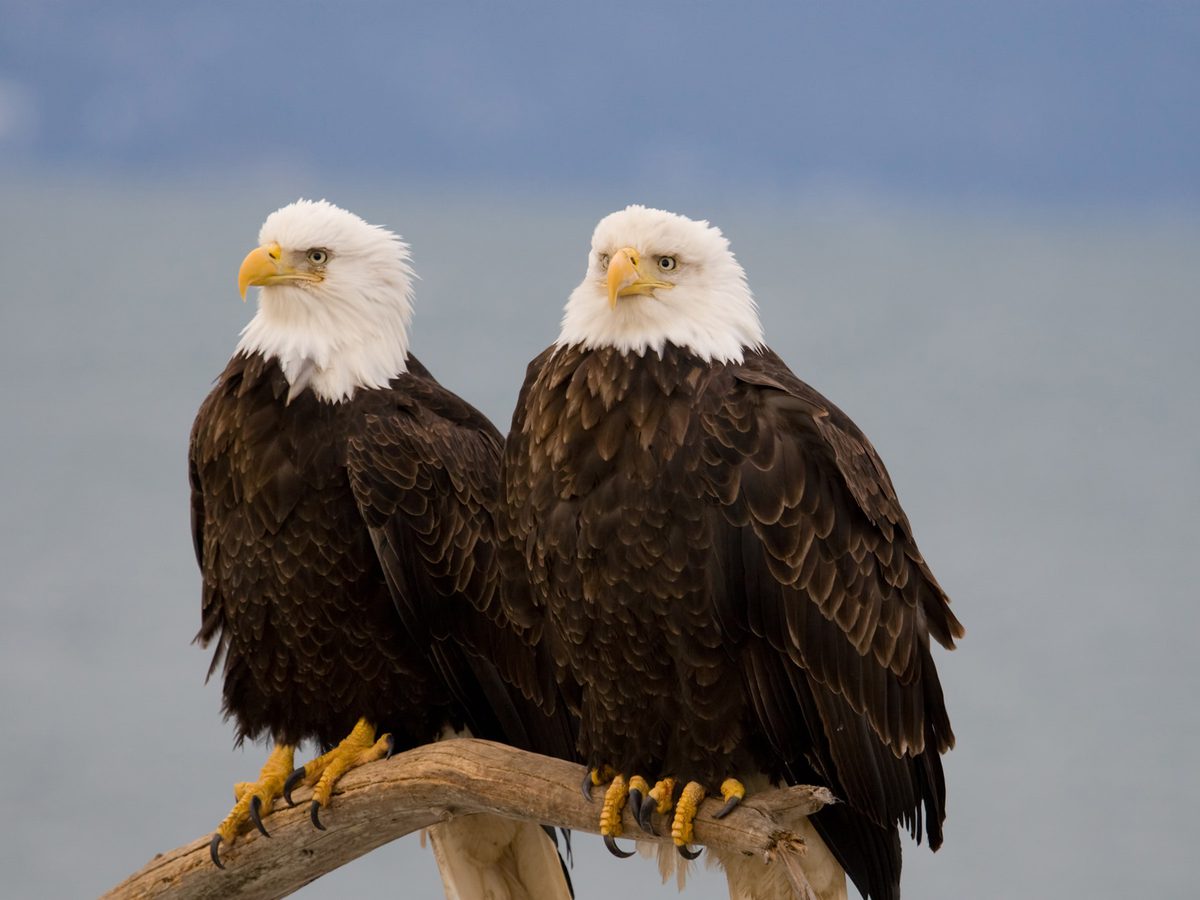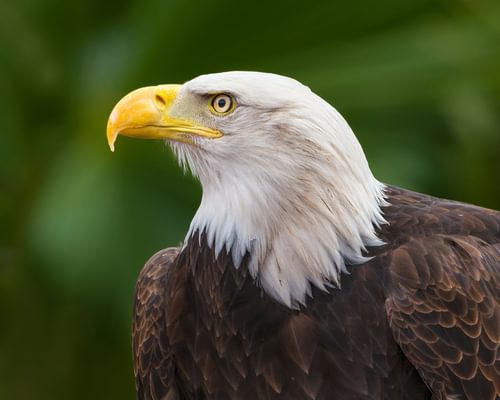Bald Eagles (Haliaeetus leucocephalus) are instantly recognizable as the national bird of the United States. These majestic birds can be seen in suitable habitats from Alaska to Mexico, including each of the lower 48 states.
They have a reputation for being faithful partners that work together to raise their chicks. So how do Bald Eagles pair up? Do they stay together?
Bald Eagles are generally monogamous. A bonded pair will mate for life until either partner dies. Their relationship ensures that both parents care for the chicks, ultimately increasing their chance of survival. Bald Eagles are partial migrants, and bonded pairs will reunite each year to use the same nest site.
They mate at their breeding territory, and the couple performs various courtship rituals to strengthen their bond. These behaviors range from death-defying acts of acrobatics to gentle displays of affection.

Generally speaking, Bald Eagles are monogamous, and bonded pairs mate for life
Most bird species form monogamous pairs, although their bond usually lasts just a single season or breeding cycle. The deep bond between a pair of Bald Eagles can last many consecutive years, which is why these birds are said to mate for life.
Scientists are discovering that not all Bald Eagles are the shining examples of fidelity we once thought. Some cheating certainly happens, mainly where these birds occur in high densities.
The pair will stick together in these instances, although the male might not be raising his own offspring. There aren’t many detailed studies of this behavior, so we’re not exactly sure how much cheating goes on.
This article unpacks the close relationship between breeding Bald Eagles. Read along to learn why these birds stick together and how they display their affection.

A pair of Bald Eagles - one perched, whilst the other about to land
Why do Bald Eagles mate for life?
Like all living species, Bald Eagles have a strong interest in seeing their genes live on in the next generation. The most obvious benefit of monogamy is that it encourages both parents to participate in caring for their young, which greatly increases their chances of survival.
Finding a new partner at the start of each breeding season and building a nest from scratch also takes unnecessary effort, and this is another reason why monogamy works so well. At worst, Bald Eagles could miss out on an entire breeding season if they failed to secure a healthy partner.
It makes sense then that long-lived birds like Bald Eagles form stable pairs that get better at raising their chicks through their combined experience. Experienced eagle pairs also tend to raise larger clutches of healthier chicks. Bald Eagle pairs work together on practically all aspects of nesting.
Continue reading to learn more about their shared responsibilities.

A nesting pair of Bald Eagles inside their nest
Constructing and repairing their nests
Bald Eagles build massive nests that grow each breeding season as they bring in more and more material. A new pair will often begin nest building at the end of the breeding season before they leave on migration. They will continue right where they left off after returning from migration.
Nest site and territory defense
Bald Eagles are highly territorial in the breeding season. They will engage in vicious fights with intruders at this time of the year, sometimes even ending in death.
Egg Incubation
Both male and female Bald Eagles develop incubation patches and sit on the eggs. Females tend to spend more time incubating than males, however.
Feeding the chicks
Female Bald Eagles spend more time at the nest than the males for the first two weeks after the eggs hatch. The male brings in most of the food at this time, although she will bring in just as much food as her partner in the coming weeks.

Adult Bald Eagle feeding young chick in the nest
Do all Bald Eagles mate for life?
Bald Eagles usually mate for life, although there are exceptions to this rule. Eagle pairs that fail to raise healthy chicks may select different partners. If one bird disappears or fails to return from migration, the remaining partner will also accept a new mate, sometimes in time to salvage the breeding season.
Nevertheless, the Bald Eagle ‘divorce rate’ is estimated at just 5 to 15% - far lower than our own!
Bald Eagles are partial migrants that can remain in the vicinity of their breeding areas throughout the year where conditions stay suitable. Where water bodies freeze over, these eagles will migrate southwards or to the coast to spend the winter.
Bald Eagle pairs do not necessarily migrate and spend the winter together, but birds that go their separate ways will return and reunite at their nest site to breed.
Bald Eagles are said to be monogamous because they stick together during the breeding season, but that does not mean they are always faithful to each other.
Females will occasionally mate with other males, leaving their unknowing partner to assist in raising chicks that are not his own.

Pair of Bald Eagles perched on a log, Alaska
How do Bald Eagles attract a mate?
Not much is known about how Bald Eagles attract a new partner. The birds are almost certainly looking for a selection of clues about the fitness of their potential mate, however. As the interest between a pair develops, these birds engage in truly mesmerizing courtship behaviors to cement their bond!
Continue reading to learn more about Bald Eagle courtship displays.
Courtship behavior
Bald Eagle courtship makes for fascinating viewing. The birds use acrobatic aerial displays to impress one another and reinforce their pair bonds. Their displays often include vocalizations, although these large eagles do not have very far-carrying calls. Not all eagle courtship is dramatic and acrobatic, however. Many courtship behaviors are gentle, including acts like beak rubbing and nest building.
Aerial displays
The Bald Eagles’ most spectacular aerial display involves both members of a pair flying up to a great height and grasping each other's feet. Their talons stay locked as the pair tumble towards the ground, only letting go at the last moment to fly to safety. Sometimes the birds even hold their grip a little too long and end up crashing into the ground!
Bald Eagles also chase each other at high speed and perform a roller-coaster-type flight with steep climbs and swoops at terrific speeds. These displays are not only about romance. Bird watchers might also see some of these acrobatic maneuvers during aggressive encounters between enemies or as a learning behavior in young birds.

A pair of Bald Eagles soaring in the mountains
Vocalizations
Bald Eagles often call to each other as a form of courtship, especially when the pair reunite at the nest site after migration. Females also have a solicitation call to signal their readiness to mate.
Other courtship behavior
Bald Eagles mate as a form of courtship, sometimes many months after the end of the breeding season. Other courtship behaviors can be more subtle and include simple acts like perching together, beak rubbing, preening each other, and working together to build and repair the nest.
Pair formation
Bald Eagles take several years to develop their adult plumage and reach sexual maturity. They first pair up and begin to breed at the age of four or five years. These eagles probably form pairs during the breeding season when aggressive and reproductive behaviors are heightened. Some birds are thought to develop pair bonds during the non-breeding season, however.

A breeding pair of Bald Eagles perched on a rock
How many times a year do Bald Eagles mate?
Bald Eagles mate several times a year, although they only produce a single brood of eaglets during the breeding season. These birds may attempt a second brood if something happens to the first and there is still enough time left in the season. Second nesting attempts are more likely to succeed in areas with a milder climate.
Bald Eagles copulate many times each day during the breeding season. The birds also mate outside of the breeding season, and this probably serves a function as a pair-bonding exercise. Bald Eagles can be rather vocal during, before, and after copulating. They do not mate in the air.
Like other birds, the male will hop onto the perched female's back to copulate. Mounting his partner is something he must do with great care, of course, considering the size of his razor-sharp talons!

A pair of Bald Eagles mating
What happens when a Bald Eagle mate dies?
Bald Eagles will take on a new breeding partner if something happens to their mate. Sometimes It can take just days for a single bird to find a new partner, although months may pass in other situations.
Do Bald Eagles mourn the loss of a mate?
Bald Eagles form powerful pair bonds, so it is easy to believe that they grieve the loss of a partner. The truth is that we just don’t know for sure yet whether Bald Eagles are capable of mourning.

